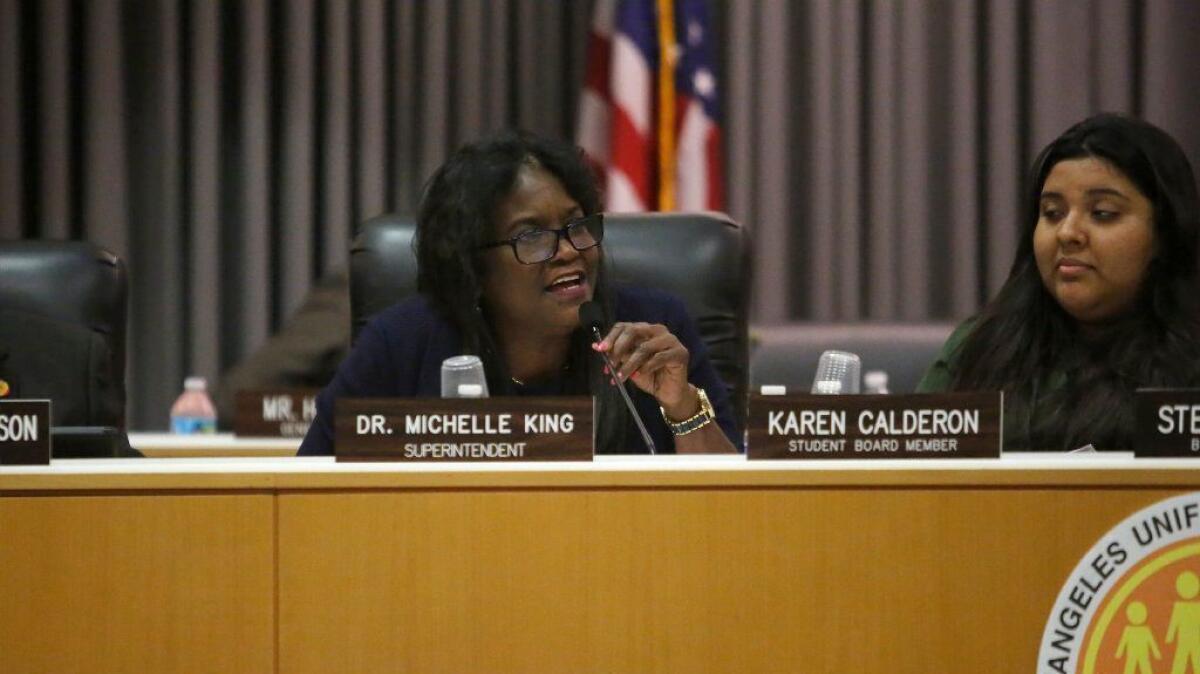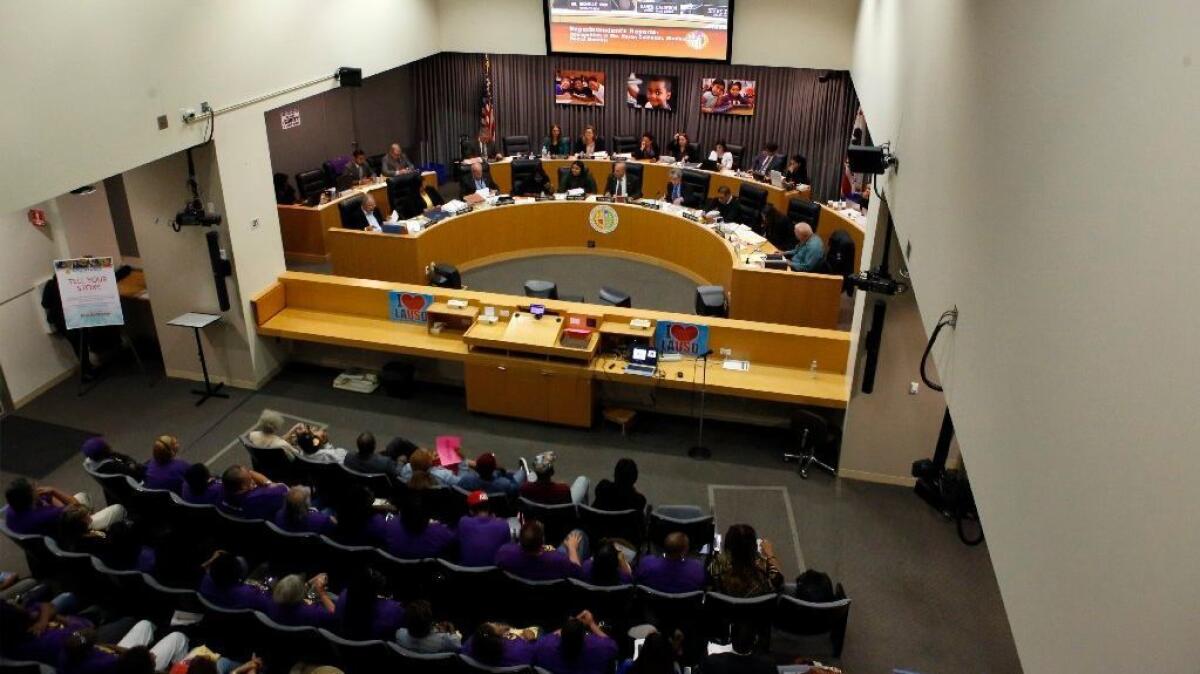L.A. Unified approves more spending and layoffs

Faced with mounting costs and declining enrollment, the Los Angeles Unified School District board approved a $7.5-billion budget Tuesday that will increase spending and lay off more than 100 library aides, clerks and other support staff next school year.
The layoffs represent a growing acknowledgement by district officials that the nation’s second-largest school district has to downsize, adjusting to the reality of population loss caused by falling birth rates, gentrification and competition from charter schools. Supt. Michelle King’s budget plan, the second of her tenure, forecasts that L.A. Unified will continue to shrink. It assumes that enrollment, which stands at about 514,000 students, will decline by nearly 34,000 students, or about 2% a year, over the next three years.
Such a drop probably would worsen the district’s financial problems because state funding is tied to enrollment and accounts for most of the district’s revenue.
Five of the seven board members voted to support King’s plan, but they did so grudgingly, with little enthusiasm for the prospect of difficult years ahead. Several called on lawmakers and Gov. Jerry Brown to provide more state funding for K-12 schools. Board member Richard Vladovic voted against the proposal, though he declined to state his reasons publicly, and board member George McKenna abstained, saying he was “lost” and “not happy” with the plan.
While nodding to the harsh realities of the district’s fiscal situation, King defended her plan as doing the least amount of harm to schools.
“Yes, we have challenges, but this budget does prioritize the school site. It does,” she said. “We were going to do everything we could to keep disruption and cuts away from the school, and this is what this budget does.”
The budget, King said, puts more money into early learning, such as transitional kindergarten, and restorative justice, which seeks to end suspensions and expulsions through counseling. Arts education also retains its funding levels, she said.
Although overall revenue is trending down, L.A. Unified’s costs are growing, particularly in areas that are difficult to control.
Paying for employees’ pensions and healthcare after they retire is eating up more of the budget — next year, it’s expected to account for 8% of general fund expenditures. Salaries and benefits, already the district’s largest cost, are increasing as L.A. Unified’s 60,000 employees age. And spending on students receiving special education services has jumped and is expected to keep climbing.
Adding pressure to this already grim fiscal outlook is the possibility that the school district could be penalized for having too many administrators on its payroll. California requires unified school districts to keep their administrator-to-teacher ratios below a certain threshold: eight administrative employees for every 100 full-time teachers.
Districts that exceed this limit — which L.A. Unified recently has — are forced to give up some of their state funding. If L.A. Unified doesn’t cut some of its administrative positions, it could forgo as much as $24 million annually, said Deputy Chief Financial Officer John Walsh.
King’s spending plan begins to address that problem by reducing the number of central office administrators, coordinators and managers by about 150 next year, part of a 30% cut to the district’s bureaucracy run out of its Beaudry headquarters. Many of these employees have tenure as school administrators or teachers and could return to these positions at reduced salaries.
No teachers are targeted for layoffs. Although declining enrollment means fewer positions for instructors, the reduction is expected to come through attrition, such as teacher retirements.
The library cuts especially bothered board member Monica Ratliff, who did not seek reelection and is leaving the board at the end of the month.
“The reality is that libraries are going to be shut just like they were before,” she said, referring to the budget cuts during the Great Recession. “I think this is a really serious issue that the district has to come to terms with publicly.”
Next year’s budget is balanced, thanks to a combination of one-time funding from the state and “realignment” steps — which include 121 layoffs — by the district. But L.A. Unified is two years away from a $422-million shortfall, according to King’s spending plan.
Proposals to close that gap are vague, and school board members are far from agreement on how to bring the district’s costs in line with its revenues.
One suggestion would have the district stop paying into a trust fund it set aside to cover retirees’ healthcare, kicking that long-term expense further into the future. Currently, the district needs about $13.6 billion more to pay for the lifetime health benefits it promised to long-term employees.
Another proposal would raise class sizes by four students in grades four through 12, which would cut school staff by about 1,000 full-time employees.
A third policy proposal could provide the most savings, according to the district’s projections. Under this plan, L.A. Unified would be allowed to seize money from individual schools’ rainy day funds, collecting whatever principals had saved. But similar plans embraced by other financially strapped school districts have proved unpopular, and district officials have said they hope to avoid going this route.
Although King’s plan calls for a 6.7% increase in spending over last year, school board members have received an earful of requests for new spending as well as spending that is allocated differently.
At the center of the controversy is $1 billion in annual state funding that the district is required to use to provide extra help to students from low-income families, students learning to speak English and those in foster care..
In 2015, a coalition of advocates and local groups sued L.A. Unified, accusing it of spending this money illegally. They said the school system had misused hundreds of millions of dollars, using the funding to pay for operations across the entire school system rather than services for the specific students it was intended to help. The district contends it used the money appropriately.
School board members are also at odds over how to spend federal funding for schools with large concentrations of poor students.
Known as Title I money, this funding is a vital revenue stream in a district where about 3 in 4 students are eligible for free or reduced-price lunch. The district’s budget assumes that this funding will be cut by about 16% next year, anticipating that the Trump administration and a Republican-controlled Congress might provide fewer dollars.
Board President Steve Zimmer and several speakers challenged this assumption and the resulting cuts that are to be suffered by schools. Zimmer said that his recent trip to Washington indicates that Congress would not support the level of cuts first proposed by Trump.
If the funding comes through, it can be added to school budgets in February, King said.

To read the article in Spanish, click here
More to Read
Sign up for Essential California
The most important California stories and recommendations in your inbox every morning.
You may occasionally receive promotional content from the Los Angeles Times.












